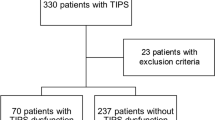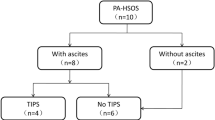Abstract
Cirrhotic ascites results from sinusoidal hypertension and sodium retention, which is secondary to a decreased effective arterial blood volume. Transjugular intrahepatic portosystemic shunt (TIPS) placement is currently indicated in cirrhotic patients with refractory ascites who require large-volume paracentesis (LVP) more than two or three times per month. TIPS placement is associated with normalization of sinusoidal pressure and a significant improvement in urinary sodium excretion that correlates with suppression of plasma renin activity, which is, itself, indicative of an improvement in effective arterial blood volume. Compared with serial LVP, placement of an uncovered TIPS stent is more effective at preventing ascites from recurring; however, increased incidence of hepatic encephalopathy and shunt dysfunction rates after TIPS placement are important issues that increase its cost. Although evidence suggests that TIPS placement might result in better patient survival, this needs to be confirmed, particularly in light of the development of polytetrafluoroethylene-covered stents. Favorable results apply to centers experienced in placing the TIPS, with the aim being to decrease the portosystemic gradient to <12 mmHg but >5 mmHg. This article reviews the pathophysiologic basis for the use of a TIPS in patients with refractory ascites, the results of controlled trials comparing TIPS placement (using uncovered stents) versus LVP, and a systematic review of predictors of death after TIPS placement for refractory ascites.
Key Points
-
In most patients with cirrhosis, ascites responds to diuretic therapy
-
TIPS placement corrects the mechanisms that lead to ascites formation and has been compared with LVP for the treatment of patients with ascites refractory to diuretics
-
TIPS placement is more effective than LVP at preventing the recurrence of ascites, but is accompanied by a higher rate of encephalopathy, despite no difference in mortality
-
Serum bilirubin is the best predictor of death in patients who undergo TIPS placement for the treatment of refractory ascites
This is a preview of subscription content, access via your institution
Access options
Subscribe to this journal
Receive 12 print issues and online access
$209.00 per year
only $17.42 per issue
Buy this article
- Purchase on Springer Link
- Instant access to full article PDF
Prices may be subject to local taxes which are calculated during checkout



Similar content being viewed by others
References
Gines P et al. (1987) Compensated cirrhosis: natural history and prognosis. Hepatology 7: 122–128
D'Amico G et al. (1986) Survival and prognostic indicators in compensated and decompensated cirrhosis. Dig Dis Sci 31: 468–475
Loureiro-Silva MR et al. (2003) Deficit in nitric oxide production in cirrhotic rat livers is located in the sinusoidal and postsinusoidal areas. Am J Physiol Gastrointest Liver Physiol 284: G567–G574
Rector WG (1986) Portal hypertension: a permissive factor only in the development of ascites and variceal bleeding. Liver 6: 221–226
Morali GA et al. (1992) Is sinusoidal portal hypertension a necessary factor for the development of hepatic ascites? J Hepatol 16: 249–250
Abraldes JG et al. (2003) Hemodynamic response to pharmacological treatment of portal hypertension and long-term prognosis of cirrhosis. Hepatology 37: 902–908
Casado M et al. (1998) Clinical events after transjugular intrahepatic portosystemic shunt: correlation with hemodynamic findings. Gastroenterology 114: 1296–1303
Hoefs JC (1983) Serum protein concentration and portal pressure determine the ascitic fluid protein concentration in patients with chronic liver disease. J Lab Clin Med 102: 260–273
Schrier RW et al. (1988) Peripheral arterial vasodilation hypothesis—a proposal for the initiation of renal sodium and water retention in cirrhosis. Hepatology 8: 1151–1157
Martin PY et al. (1998) Nitric oxide as a mediator of hemodynamic abnormalities and sodium and water retention in cirrhosis. N Engl J Med 339: 533–541
Martin PY et al. (1998) Nitric oxide synthase (NOS) inhibition for one week improves renal sodium and water excretion in cirrhotic rats with ascites. J Clin Invest 101: 235–242
Arroyo V et al. (1996) Definition and diagnostic criteria of refractory ascites and hepatorenal syndrome in cirrhosis. Hepatology 23: 164–176
Salerno F et al. (1993) Survival and prognostic factors of cirrhotic patients with ascites: a study of 134 outpatients. Am J Gastroenterol 88: 514–519
Castells A et al. (1994) Impact of shunt surgery for variceal bleeding in the natural history of ascites in cirrhosis: a retrospective study. Hepatology 20: 584–591
Orloff MJ et al. (1997) Experimental, clinical, and metabolic results of side-to-side portacaval shunt for intractable cirrhotic ascites. J Am Coll Surg 183: 557–570
Voorhees ABJ et al. (1970) Portasystemic shunting procedures for portal hypertension. Twenty-six year experience in adults with cirrhosis of the liver. Am J Surg 119: 501–505
Wong F et al. (1995) Transjugular intrahepatic portosystemic stent shunt: effects on hemodynamics and sodium homeostasis in cirrhosis and refractory ascites. Ann Intern Med 122: 816–822
Quiroga J et al. (1995) Transjugular intrahepatic portal-systemic shunt in the treatment of refractory ascites: effect on clinical, renal, humoral, and hemodynamic parameters. Hepatology 21: 986–994
Wong F et al. (1997) The mechanism of the initial natriuresis after transjugular intrahepatic portosystemic shunt. Gastroenterology 112: 899–907
Wong W et al. (1999) Long-term renal sodium handling in patients with cirrhosis treated with transjugular intrahepatic portosystemic shunts for refractory ascites. Am J Med 106: 315–322
Gerbes AL et al. (1998) Renal effects of transjugular intrahepatic portosystemic shunt in cirrhosis: comparison of patients with ascites, with refractory ascites or without ascites. Hepatology 28: 683–688
Somberg KA et al. (1995) Transjugular intrahepatic portosystemic shunts for refractory ascites: assessment of clinical and hormonal response and renal function. Hepatology 21: 709–716
Lebrec D et al. (1996) Transjugular intrahepatic portosystemic shunts: comparison with paracentesis in patients with cirrhosis and refractory ascites: a randomized trial. J Hepatol 25: 135–144
Garcia-Tsao G (2005) Transjugular intrahepatic portosystemic shunt in the management of refractory ascites. Semin Interventional Rad 22: 278–286
Russo MW et al. (2003) Transjugular intrahepatic portosystemic shunt for refractory ascites: an analysis of the literature on efficacy, morbidity, and mortality. Am J Gastroenterol 98: 2521–2527
Sanyal AJ et al. (1994) Portosystemic encephalopathy after transjugular intrahepatic portosystemic shunt: results of a prospective controlled study. Hepatology 20: 46–54
Nolte W et al. (1998) Portosystemic hepatic encephalopathy after transjugular intrahepatic portosystemic shunt in patients with cirrhosis: clinical, laboratory, psychometric, and electroencephalographic investigations. Hepatology 28: 1215–1225
Riggio O et al. (2005) Pharmacological prophylaxis of hepatic encephalopathy after transjugular intrahepatic portosystemic shunt: a randomized controlled study. J Hepatol 42: 674–679
Riggio O et al. (1996) Hepatic encephalopathy after transjugular intrahepatic portosystemic shunt. Incidence and risk factors. Dig Dis Sci 41: 578–584
Hassoun Z et al. (2001) Relationship between pre-TIPS liver perfusion by the portal vein and the incidence of post-TIPS chronic hepatic encephalopathy. Am J Gastroenterol 96: 1205–1209
Bureau C et al. (2004) Improved clinical outcome using polytetrafluoroethylene-coated stents for TIPS: results of a randomized study. Gastroenterology 126: 469–475
Boyer TD and Haskal ZJ (2005) The role of transjugular intrahepatic portosystemic shunt in the management of portal hypertension. Hepatology 41: 386–400
Moore KP et al. (2003) The management of ascites in cirrhosis: report on the consensus conference of the International Ascites Club. Hepatology 38: 258–266
Gines A et al. (1996) Randomized trial comparing albumin, dextran-70 and polygeline in cirrhotic patients with ascites treated by paracentesis. Gastroenterology 111: 1002–1010
Ruiz del Arbol L et al. (1997) Paracentesis-induced circulatory dysfunction: mechanism and effect on hepatic hemodynamics in cirrhosis. Gastroenterology 113: 579–586
Sola-Vera J et al. (2003) Randomized trial comparing albumin and saline in the prevention of paracentesis-induced circulatory dysfunction in cirrhotic patients with ascites. Hepatology 37: 1147–1153
Rossle M et al. (2000) A comparison of paracentesis and transjugular intrahepatic portosystemic shunting in patients with ascites. N Engl J Med 342: 1701–1707
Gines P et al. (2002) Transjugular intrahepatic portosystemic shunting versus repeated paracentesis plus intravenous albumin for refractory ascites in cirrhosis: a multicenter randomized comparative study. Gastroenterology 123: 1839–1847
Sanyal AJ et al. (2003) The North American Study for the Treatment of Refractory Ascites. Gastroenterology 124: 634–641
Salerno F et al. (2004) Randomized controlled study of TIPS versus paracentesis plus albumin in cirrhosis with severe ascites. Hepatology 40: 629–635
Saab S et al. (2004) TIPS versus paracentesis for cirrhotic patients with refractory ascites. The Cochrane Database of Systematic Reviews, Issue 3, Art. No CD004889
Deltenre P et al. (2005) Transjugular intrahepatic portosystemic shunt in refractory ascites: a meta-analysis. Liver Int 25: 349–356
D'Amico G et al. (2005) Uncovered transjugular intrahepatic portosystemic shunt for refractory ascites: a meta-analysis. Gastroenterology 129: 1282–1293
Albillos A et al. (2005) A meta-analysis of transjugular intrahepatic portosystemic shunt versus paracentesis for refractory ascites. J Hepatol 43: 990–996
Luca A et al. (1999) TIPS for prevention of recurrent bleeding in patients with cirrhosis: meta-analysis of randomized clinical trials. Radiology 212: 411–421
Campbell MS et al. (2005) Quality of life in refractory ascites: transjugular intrahepatic portal-systemic shunting versus medical therapy. Hepatology 42: 635–640
Chalasani N et al. (2000) Determinants of mortality in patients with advanced cirrhosis after transjugular intrahepatic portosystemic shunting. Gastroenterology 118: 138–144
Malinchoc M et al. (2000) A model to predict poor survival in patients undergoing transjugular intrahepatic portosystemic shunts. Hepatology 31: 864–871
Russo MW et al. (2002) Predictors of mortality and stenosis after transjugular intrahepatic portosystemic shunt. Liver Transpl 8: 271–277
Angermayr B et al. (2003) Child–Pugh versus MELD score in predicting survival in patients undergoing transjugular intrahepatic portosystemic shunt. Gut 52: 879–885
Thuluvath PJ et al. (2003) TIPS for management of refractory ascites: response and survival are both unpredictable. Dig Dis Sci 48: 542–550
Alessandria C et al. (2004) Application of the model for end-stage liver disease score for transjugular intrahepatic portosystemic shunt in cirrhotic patients with refractory ascites and renal impairment. Eur J Gastroenterol Hepatol 16: 607–612
ter Borg PC et al. (2004) Transjugular intrahepatic portosystemic shunts: long-term patency and clinical results in a patient cohort observed for 3–9 years. Radiology 231: 537–545
Membreno F et al. (2005) Differences in long-term survival after transjugular intrahepatic portosystemic shunt for refractory ascites and variceal bleed. J Gastroenterol Hepatol 20: 474–481
D'Amico G et al. (2006) Natural history and prognostic indicators of survival in cirrhosis. A systematic review of 118 studies. J Hepatol 44: 217–231
Gerbes AL and Gulberg V (2005) Benefit of TIPS for patients with refractory or recidivant ascites: serum bilirubin may make the difference. Hepatology 41: 217
Ferral H et al. (1993) Refractory ascites: early experience with transjugular intrahepatic portosystemic shunt. Radiology 189: 795–80155
Author information
Authors and Affiliations
Corresponding author
Ethics declarations
Competing interests
The author declares no competing financial interests.
Rights and permissions
About this article
Cite this article
Garcia-Tsao, G. The transjugular intrahepatic portosystemic shunt for the management of cirrhotic refractory ascites. Nat Rev Gastroenterol Hepatol 3, 380–389 (2006). https://doi.org/10.1038/ncpgasthep0523
Received:
Accepted:
Issue Date:
DOI: https://doi.org/10.1038/ncpgasthep0523



